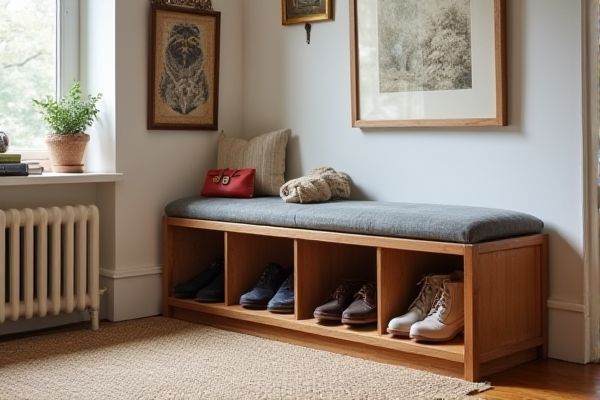
A shoe bench provides both seating and storage, making it a versatile piece of furniture ideal for entryways or bedrooms, while a shoe shelf focuses solely on organizing footwear without the added comfort of a seat. Explore this article to discover which option best suits your space and lifestyle needs.
Table of Comparison
| Feature | Shoe Bench | Shoe Shelf |
|---|---|---|
| Function | Provides seating and shoe storage | Offers shoe storage only |
| Design | Bench with built-in shelves or compartments | Open or closed shelving units |
| Space Usage | Combines seating and storage, ideal for entryways | Focuses solely on maximizing shoe storage space |
| Material | Wood, metal, upholstered options | Wood, metal, plastic |
| Price Range | Moderate to high | Low to moderate |
| Best For | Entryways, mudrooms, multi-functional use | Closets, bedrooms, shoe organization |
Introduction: Shoe Bench vs Shoe Shelf
A shoe bench combines seating and storage, making it an ideal solution for entryways or bedrooms where convenience and functionality are essential. A shoe shelf primarily focuses on maximizing vertical storage space, helping to keep footwear organized and visible. Choosing between a shoe bench and a shoe shelf depends on the need for seating versus compact, layered shoe arrangement.
Defining Shoe Benches
A shoe bench is a versatile piece of furniture combining seating and storage, designed to help you organize your footwear while providing a convenient place to sit. Unlike a shoe shelf, which primarily offers upright storage without seating, a shoe bench typically includes compartments or cubbies beneath the seat for easy access to shoes. This dual functionality makes a shoe bench ideal for entryways or closets where space optimization and comfort are priorities.
What is a Shoe Shelf?
A shoe shelf is a storage solution designed to neatly organize multiple pairs of shoes in a compact, accessible space. Unlike a shoe bench, which combines seating with storage, a shoe shelf focuses solely on maximizing vertical or horizontal shoe storage without providing a sitting area. Your choice depends on whether you need just efficient shoe organization or a functional spot to sit while putting on shoes.
Comparing Storage Capacity
A shoe bench typically offers greater storage capacity with multiple compartments or cubbies that can hold shoes neatly while doubling as seating. In contrast, a shoe shelf prioritizes vertical space with multiple tiers but may lack enclosed storage, making it less efficient for organizing a larger shoe collection. Choosing between the two depends on the volume of shoes and preferred accessibility, with shoe benches ideal for bulkier storage and shoe shelves suitable for compact, visible arrangements.
Space Efficiency: Bench vs Shelf
A shoe bench combines seating and storage, offering dual functionality that maximizes space efficiency in entryways or small rooms. Shoe shelves prioritize vertical storage, fitting more pairs in a compact footprint but lack seating capabilities. Choosing between a shoe bench and a shoe shelf depends on prioritizing multipurpose use or maximizing shoe capacity within limited square footage.
Aesthetic Appeal & Home Decor
A shoe bench offers a combination of functionality and aesthetic appeal by providing seating along with storage, often enhancing the entryway decor with its upholstered cushions and sleek design. In contrast, a shoe shelf emphasizes minimalism and open storage, allowing shoes to be displayed in an organized manner that complements modern or casual home styles. Both options contribute to home decor, but the shoe bench adds warmth and comfort, making it a focal point, while the shoe shelf maintains a clean, space-saving look.
Comfort and Additional Features
Shoe benches offer enhanced comfort with cushioned seating, making them ideal for putting on or taking off shoes, while shoe shelves focus primarily on storage without seating. Many shoe benches include additional features like built-in compartments, storage bins, or lift-up lids for organizing accessories, whereas shoe shelves typically provide multiple tiers or cubbies for efficient shoe arrangement. Comfort-oriented designs and multifunctional storage options make shoe benches a versatile choice beyond simple shoe storage solutions.
Durability and Material Choices
Shoe benches typically feature sturdy hardwood or metal frames combined with cushioned tops, offering enhanced durability and comfort for seating. In contrast, shoe shelves often utilize lighter materials such as MDF or plastic, which may prioritize cost-effectiveness over long-term sturdiness. Selecting solid wood or metal options significantly boosts the lifespan of both shoe benches and shelves, but benches generally withstand heavier use due to their dual functionality.
Best Use Cases for Each Option
Shoe benches are ideal for entryways or mudrooms where you need both seating and storage, allowing you to sit comfortably while putting on or removing shoes. Shoe shelves work best in closets or narrow hallways where maximizing vertical space and keeping shoes organized and visible is essential. Choosing between a shoe bench and a shoe shelf depends on your space layout and whether you prioritize convenience, seating, or maximizing storage capacity.
Conclusion: Which is Better for You?
A shoe bench offers the dual benefit of seating and storage, making it ideal for entryways where you can comfortably put on or take off shoes while keeping them organized. A shoe shelf provides a more compact, space-saving solution ideal for small areas or minimalist designs, allowing your shoes to be visible and easily accessible. Your choice depends on your space, comfort needs, and whether you value multifunctional furniture or streamlined storage.
 homyna.com
homyna.com